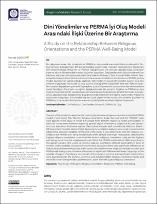| dc.contributor.author | Gencer, Nevzat | |
| dc.date.accessioned | 2023-11-21T12:52:33Z | |
| dc.date.available | 2023-11-21T12:52:33Z | |
| dc.date.issued | 2023 | en_US |
| dc.identifier.citation | Gencer, N. (2023). Dini Yönelimler ve PERMA İyi Oluş Modeli Arasındaki İlişki Üzerine Bir Araştırma. İlahiyat Tetkikleri Dergisi, (59), 82-97. | en_US |
| dc.identifier.issn | 2458-7508 | |
| dc.identifier.issn | 2602-3946 | |
| dc.identifier.uri | https://hdl.handle.net/11491/8695 | |
| dc.description.abstract | Bu çalışmanın amacı dini yönelimler ile PERMA iyi oluş modeli arasındaki ilişkiyi incelemektir. Türkiye’nin farklı bölgelerinden 875 kişinin katıldığı araştırmada “Yeniden Yapılandırılmış Müslüman Dini Yönelim Ölçeği (MROS-R)” ve “PERMA” ölçeğinin yanı sıra cinsiyet, yaşadığı bölge, öznel gelir algısı ve eğitim düzeyine ilişkin anket ölçümleri uygulandı. Değişkenler arası ilişkiyi incelemek için betimsel analizler ve korelasyonel istatistikler (Mann-Whitney U Testi, Kruskal-Wallis H Testi, Spearman Korelâsyon Analizi) kullanıldı. Araştırma sonunda örneklemin dini yönelim ve PERMA iyi oluş modeli düzeylerinin yüksek olduğu saptandı. Katılımcılar en yüksek dini yönelim puanını içsel dini yönelim ölçeğinden, en yüksek iyi oluş puanını ise bağlanma ölçeğinden elde etti. PERMA ölçekleri cinsiyet değişkenine göre farklılaşmazken, içsel dini yönelimin puanları kadınlar lehine anlamlı olarak farklılaştı. Öznel gelir ve eğitim değişkenlerinde dini yönelim ölçekleri ve PERMA iyi oluş ölçeklerinden elde edilen puanlarda gruplar arasında çeşitli düzeylerde anlamlı farklılıklar bulundu. Ancak yaşadığı bölge değişkeninde gruplar arasında anlamlı bir farklılaşma saptanmadı. Araştırma sonucunda sorgulayıcı dini yönelim dışında içsel, dışsal ve katı kuralcı dini yönelim biçimleri ile PERMA iyi oluş modeli alt boyutları arasında pozitif yönde ve anlamlı ilişkiler bulgulandı. | en_US |
| dc.description.abstract | The aim of this study is to examine the relationship between religious orientations and the PERMA model of well-being. The "Muslim Religious Orientation Scale–Revised" and the "PERMA" scale were applied in the study, in which 875 people from different regions of Turkey participated. In addition, survey measurements regarding gender, region of residence, subjective income perception, and education level were applied. Descriptive analyses and correlational statistics (Mann– Whitney U test, Kruskal–Wallis H test, Spearman’s correlation analysis) were used to examine the relationship between variables. At the end of the study, it was determined that the religious orientation and PERMA well-being model levels of the sample were high. Participants obtained the highest religious orientation score from the intrinsic religious orientation scale and the highest well-being score from the engagement scale. While the PERMA scales did not differ according to the gender variable, the scores of intrinsic religious orientation differed significantly in favor of women. In the variables of subjective income and education, there were significant differences at various levels between the groups in the scores obtained from the religious orientation scales and PERMA well-being scales. However, there was no significant difference between the groups in the variable of region of residence. As a result of the research, positive and significant relationships were found between the intrinsic, extrinsic, and fundamentalist religious orientation styles and the PERMA well-being model subdimensions, apart from the quest religious orientation | en_US |
| dc.language.iso | tur | en_US |
| dc.publisher | AVES | en_US |
| dc.relation.ispartof | İlahiyat Tetkikleri Dergisi | en_US |
| dc.rights | info:eu-repo/semantics/openAccess | en_US |
| dc.subject | Din Psikolojisi | en_US |
| dc.subject | Dini Yönelim | en_US |
| dc.subject | Dindarlık | en_US |
| dc.subject | PERMA | en_US |
| dc.subject | İyi Oluş | en_US |
| dc.subject | Psychology of Religion | en_US |
| dc.subject | Religious Orientation | en_US |
| dc.subject | Religiosity | en_US |
| dc.subject | PERMA | en_US |
| dc.subject | Well-Being | en_US |
| dc.title | Dini Yönelimler ve PERMA İyi Oluş Modeli Arasındaki İlişki Üzerine Bir Araştırma | en_US |
| dc.title.alternative | A Study on the Relationship Between Religious Orientations and the PERMA Well-Being Model | en_US |
| dc.type | article | en_US |
| dc.department | Hitit Üniversitesi, Sağlık Bilimleri Fakültesi, Sosyal Hizmet Bölümü | en_US |
| dc.authorid | 0000-0001-9619-8119 | en_US |
| dc.identifier.volume | 59 | en_US |
| dc.identifier.startpage | 87 | en_US |
| dc.identifier.endpage | 92 | en_US |
| dc.relation.publicationcategory | Makale - Uluslararası Hakemli Dergi - Kurum Öğretim Elemanı | en_US |
| dc.contributor.institutionauthor | Gencer, Nevzat | |
| dc.identifier.doi | 10.5152/ilted.2023.23293 | en_US |
| dc.description.wospublicationid | WOS:001035674100009 | en_US |


















